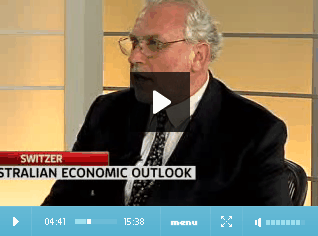
Earlier this month, the Chief of BIS Shrapnel, Dr Frank Gelber, gave an interesting interview on Switzer on the outlook for the housing market (click to watch video). The key discussion on the housing market starts from 5.15, where Dr Gelber says the following (paraphrased):
- The doomsdayers are “discredited”. “That was crazy stuff… they have frightened a lot of people and that’s caused people from hanging off from making investment decisions”.
- Australia has a “deficiency of housing stock”, we’ve got a “solid but not spectacular economy that will be picking up pace”, and “rents are rising quite aggressively because of the shortage of stock and rental yields are going up”. Therefore, “people will start to invest in property again slowly”.
- States where the deficiency of stock are the greatest – namely New South Wales, Queensland and Western Australia – will experience 15% to 20% price growth over the next three years… “slow at first and then picking up pace”.
- “We haven’t actually seen a huge decline or anything… the market has really stalled – a little bit up, a little bit down, bit by bit. There will be differences between suburbs and values of housing”.
- “This is not a bad time to buy. But there are better investment options”.
I have a number of issues with Dr Gelber’s arguments.
First, it’s a little bit rich of Dr Gelber to lambast the “doomsdayers” for making hysterical predictions when he himself has made equally outlandish forecasts of house price growth. For example, in July last year, near the peak of the last housing cycle, Dr Gelber made the following bold prediction on the future direction of house prices in Australia [my emphasis]:
Frank Gelber gave members at a Real Estate Institute of Victoria lunch a very optimistic forecast for house prices, as reported in the Sydney Morning Herald.
“At the end of the day, we haven’t got a bubble in our residential market. We’re undersupplied, not oversupplied … [House] prices will go up another 30 per cent over the next three years”…
“We’re not over-geared, we’re not overvalued and we’re not oversupplied,” he said. ”I can’t remember in the last 30 years a time when I have been more comfortable and optimistic about investment in the market”.
Australia’s recovery would not be affected by global economic uncertainty, he added.
While there are still two years to go, Dr Gelber’s prediction is looking shaky to say the least, as evidenced by the below RP Data chart:
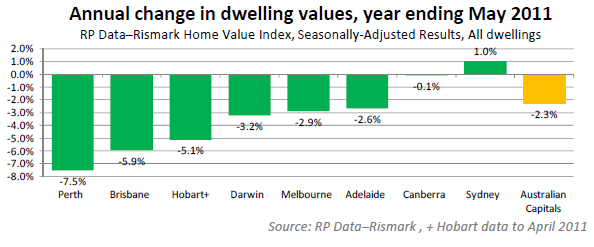
Second, Dr Gelber wrongly claims that “rents are rising quite aggressively because of the shortgage of stock and rental yields are going up”. I don’t know what data Dr Gelber uses, but it obviously is not RP Data’s which shows the following:
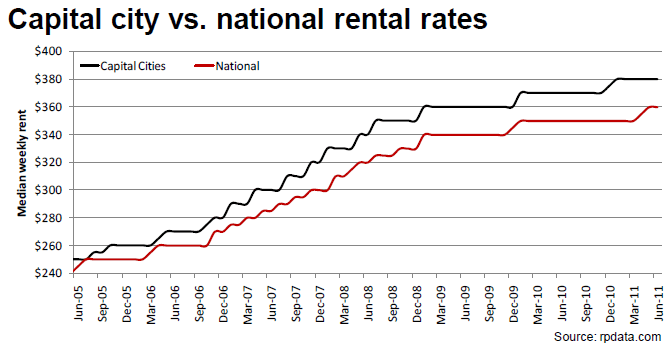
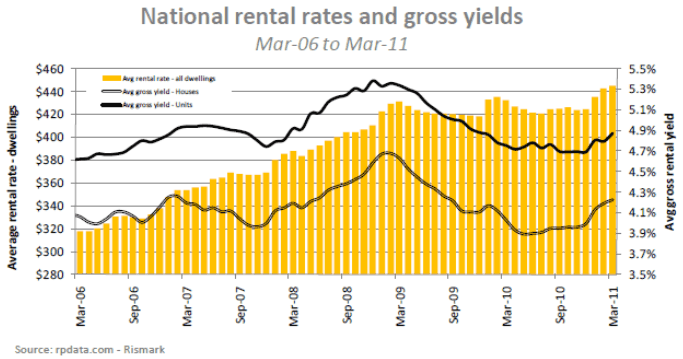
From the first RP Data chart, median capital city rents and national rents have risen only $20 per week since March 2009, which represents growth of only 5.5% and 5.9% respectively over the past nine quarters. When this anemic rental growth is compared against the growth in the consumer price index (CPI), which has risen by 7.3% over the same period, it is evident that rents have been falling in real terms.
With rents more or less stagnating, the improvement in rental yields has occurred because housing values have fallen across the nation, with the exception of Sydney (see first chart).
These realities then bring into question Dr Gelber’s assertion that “people will start to invest in property again…”. With gross capital city rental yields – 4.2% for houses and 5.0% for units – still well below discount mortgage interest rates (currently 7.05%), and capital growth muted, where is the incentive for investors to flock back to the housing market?
Third, Dr Gelber’s claim that “we haven’t actually seen a huge decline or anything… the market has really stalled – a little bit up, a little bit down, bit by bit” is spurious. Sure, on a national basis, annual capital city home prices are down ‘only’ 2.3% (first chart). However, Perth (-7.5%) and Brisbane (-5.9%) are down sharply. And that’s before adjust for 3.6% inflation over he past year.
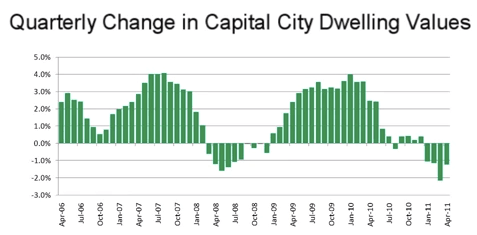
Finally, Dr Gelber’s suggestion that it is “not a bad time to buy…” seems a little bizarre given: the obvious overvaluation in the housing market; the very poor yields on offer; overall cautiousness about the strength of the economy; the heavy debt loads already carried by households; as well as rising inflationary pressures and the expected increases in mortgage interest rates (which BIS forecasts will reach 9.4% by the end of 2013).
And if mortgage interest rates do manage to reach 9.4% as forecast by BIS, there is little likelihood that BIS’ predictions of 15% to 20% growth in Sydney, Brisbane and Perth home prices in three years would be achieved – maintaining their current valuations in real terms will be hard enough.

